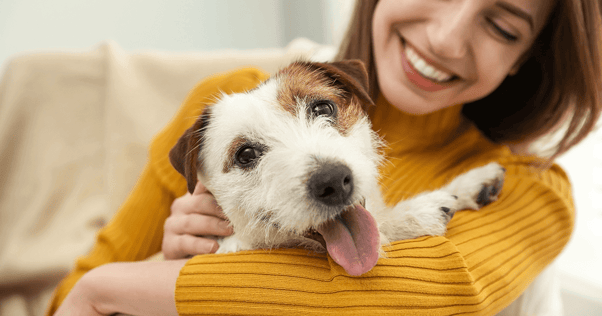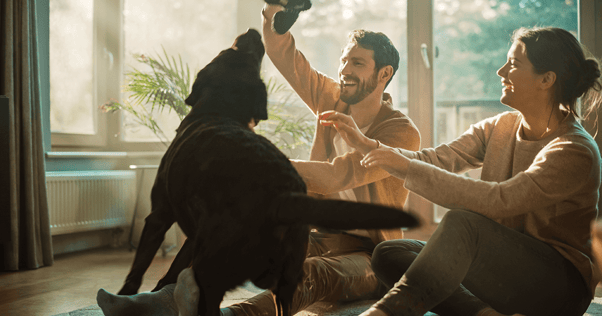Stress impacts us all to some extent and how we handle stress as humans, varies from person to person. There are many ways that we humans seek comfort in stressful situations – we may decide to remove ourselves from a situation to avoid the stress, or do some exercise to get the endorphins pumping, or we may find that speaking to a friend or counsellor helps.
But how can we make our dogs feel comfortable when they find themselves in a stressful situation? Like humans, there are many things that can make a dog feel stressed:
- They may not like strangers
- They could be frightened of sudden noise, like thunder or fireworks
- It’s possible they are scared of other dogs
- They don’t like being left home alone
- They may fear a trip to the vet and start trembling
- Or they may be feeling ill

Recognizing stress in your dog
It’s important that you’re able to recognize when your dog is feeling relaxed versus when they’re stressed or scared, so that you can take the right steps to comfort them.
| |
When your dog is relaxed
|
Signs your dog is stressed
|
|
Ear position
|
Relaxed and alert
|
Ears moved back against the head
|
|
Tail position
|
Tail held high, neutral, or relaxed wagging
|
Tail will be tucked between hind legs or held rigid
|
|
Eyes
|
Relaxed and content with a casual gaze
|
Averting their gaze, dilated pupils, a fixed stare or very wide eyes showing more white than usual.
|
|
Body position
|
Weight bearing on all four legs and a relaxed appearance
|
A lifted forepaw, or shifting weight to rear legs, or cowering
|
|
Vocal
|
Barking or whining in normal situations like getting excited
|
Barking or whining increased to get attention or for no apparent reason
|
|
Hiding or escaping
|
Not hiding, relaxed and welcoming, or happy to settle
|
Stressed dogs may move behind their owners to hide, or may disappear behind furniture.
|
|
Panting
|
Dogs normally pant when hot, excited, or after exercise
|
Panting when they are not hot, excited and have not exercised.
|
|
Yawning, drooling or licking
|
Dogs will yawn normally when they are tired or bored. They may also lick or drool around mealtimes.
|
A stressful yawn is more prolonged and intense than a sleepy yawn. Dogs may also drool and lick excessively when nervous.
|
|
Bodily functions
|
Normal urinating and bowel habits and enjoying their food.
|
Loss of bowel function, or defaecating around the home or in their bed. Altered appetite.
|

18 Ways to Comfort Your Dog in Stressful Situations
If your dog is showing signs of stress or if they appear scared, there are a number of ways you can comfort them.
- It’s important that you stay calm and talk to them in a reassuring tone.
- Try and work out the triggers and take steps to avoid any situations that you know will make them feel stressed.
- Make sure they have a regular daily exercise routine, as this is a great way for your dog to cope better with everyday life.
- Mental stimulation is important! Playing games with your dog, like fetch or hide and seek will help them gain everyday confidence and grow your bond. Make sure you have toys that will keep our dog occupied, especially if you have to leave them home alone. Try some DIY projects, like making your dog’s very own snuffle mat – a relaxing hobby for you and a destressor for your dog too!
- Train your dog to help them adjust to situations such as being home alone, or helping to familiarise them with unexpected sounds can also help them feel confident and cope better.
- Use an ADAPTIL Diffuser, plugged in where your dog spends most of their time will create a constant, reassuring environment for them.
- Put an old item of your clothing, like a t-shirt, in their bed – your scent will help them feel secure.
- Chewing is a natural destressor for dogs, so providing chew toys such as a Kong will help.
- Try to distract them. If, for example, you are at the vet (when many dogs seem to get stressed or scared), give them their favourite toy to play with, and reassure them by stroking them and talking to them in a calm voice. Reward them for being calm.
- If they have a fear of travelling in cars, careful training can help them to become used to travelling. ADAPTIL Transport can also help to make journeys easier.
- If they get stressed with visitors to the home, make sure they have somewhere that they can retreat to. This can be their bed, or a doggie den that you have created for them with their favourite toys - and with an ADAPTIL Diffuser plugged in close by.
- Take some time out to spend time alone with them – even if it is just sitting on the sofa together, watching TV.
- If your dog is nervous of loud noises, like fireworks or thunder, take steps to reassure them. There are national firework celebrations held all over the world, so when you know there will be a firework display in your area, take steps to help them stay calm. ADAPTIL works to calm anxiety, fear and relieve stress in dogs.
- Try playing music, or leaving the TV or radio playing to soothe them.
- Help your dog to feel confident about life – reward them when they make the right choice (e.g. independently choosing to settle on a mat) and learn new things (starting with easy cues/tricks so they are set up for success).
- Don’t punish your dog for not coping as this may make the problem worse for your dog and could affect your relationship.
- If your dog’s stress continues, have them checked out by a vet – there may be a medical reason why your dog is finding a situation difficult to cope with.
- Seek professional behavioural advice to help your dog with the situation they find difficult.



